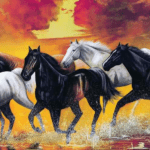The Seven Running Horses, a powerful and evocative symbol in Sanatan Dharma, have captivated the imagination and reverence of devotees for centuries. Their majestic presence adorns temples, scriptures, and works of art, serving as a constant reminder of their profound significance in Hindu traditions and rituals.
Mythological Origins
The Seven Running Horses trace their origins to the ancient Hindu myth of the Sun God Surya’s chariot pulled by seven celestial steeds. Each horse embodies the essence of a specific planet and its associated qualities, representing the harmonious balance of the cosmos.
- Surya: The Sun God, represented by the first horse, symbolizes leadership, vitality, and the illuminating power of knowledge.
- Chandra: The Moon God, represented by the second horse, signifies intuition, creativity, and the nurturing aspects of nature.
- Mangal: The God of War, represented by the third horse, embodies courage, determination, and the ability to overcome challenges.
- Budh: The Planet of Mercury, represented by the fourth horse, symbolizes intellect, communication, and the pursuit of wisdom.
- Brihaspati: The Planet of Jupiter, represented by the fifth horse, signifies abundance, expansion, and the pursuit of higher knowledge.
- Shukra: The Planet of Venus, represented by the sixth horse, embodies love, harmony, and the pursuit of material wealth.
- Shani: The Planet of Saturn, represented by the seventh horse, signifies discipline, perseverance, and the ability to face challenges with resilience.
Symbolic Significance in Sanatan Dharma
The Seven Running Horses hold deep symbolic resonance within Sanatan Dharma, transcending mere mythological figures. They represent the interplay of cosmic forces, the divine energy that permeates the universe, and the qualities that lead to personal and spiritual fulfillment.
- The Cycle of Life: The horses’ continuous movement symbolizes the perpetual cycle of creation, preservation, and destruction, mirroring the cyclical nature of life itself.
- Spiritual Ascent: The horses’ ascent towards the heavens represents the soul’s journey towards enlightenment and liberation from the material world.
- Harmony and Balance: The horses’ harmonious alignment reflects the importance of balance and equilibrium in all aspects of life, both physical and spiritual.
Role in Rituals and Celebrations
The Seven Running Horses play a significant role in various Sanatan Dharma rituals and celebrations, embodying auspiciousness, prosperity, and divine blessings.
- Temple Murals: The horses are often depicted in temple murals and sculptures, symbolizing the divine presence and protection that permeates sacred spaces.
- Ritual Offerings: Images of the horses are incorporated into ritual offerings, seeking their blessings for success, prosperity, and protection from harm.
- Festival Processions: The horses are featured in festival processions, symbolizing the triumph of good over evil and the blessings bestowed upon devotees.
- Astrological Interpretation: The horses’ positions in the zodiac are considered astrologically significant, influencing individual destinies and the overall cosmic balance.
Contemporary Relevance
The Seven Running Horses continue to hold relevance in contemporary Sanatan Dharma, transcending their mythological and ritualistic significance. They serve as a source of inspiration, reminding individuals of their inherent strength, resilience, and potential to achieve their goals.
- Motivational Symbol: The horses’ powerful imagery serves as a motivational symbol, encouraging individuals to embrace their inner strength and pursue their aspirations with unwavering determination.
- Cultural Symbol: The horses represent the rich cultural heritage of Sanatan Dharma, connecting generations and fostering a sense of shared identity and belonging.
- Universal Symbol: The horses’ symbolism extends beyond religious boundaries, resonating with individuals seeking personal growth, success, and harmony in their lives.
Conclusion
The Seven Running Horses, with their enduring symbolism and profound significance, continue to inspire and guide individuals within Sanatan Dharma and beyond. Their presence serves as a constant reminder of the divine power within each of us, the potential to overcome challenges, and the pursuit of a life filled with prosperity, harmony, and fulfillment.


